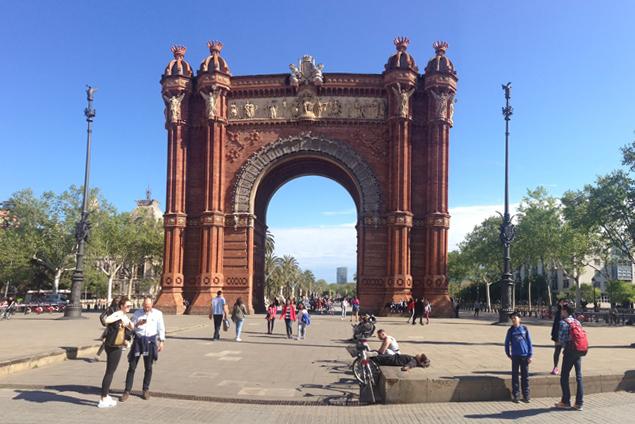Online bookings
24 hours a day
0044 (0) 20 3239 1595
English Phone
Mon-Fri: 8-16:00 GMT
Customer Service
The Arco del Triunfo (the Triumphal Arch), as can be discerned from its name, is an imposing symbol of the city, built to honor the economic, artistic and scientific progress of mankind.
These characteristics make it one of a kind as, usually, the triumphal arches, like those located in Rome or Paris, were built to commemorate military victories. This is one of the many unmissable stops during your tour of the city.

The Triumphal Arch, known as the Arc de Triomf in Catalan, was designed by the architect Josep Vilaseca. Its construction was commissioned, together with the famous Passeig de Lluís Companys, for the Universal Exhibition of 1888 and became symbolic of the entry to this exhibition. The area that surrounds the Arch is a spot that is very popular both with the locals and with tourists as a space that hosts plenty of events during the course of the year, including the celebrations of the Diada. It is a very central area of the city which is about 1 km from the Gothic Quarter and runs the length of the avenue of the Passeig de Lluís Companys until it reaches the wonderful Parc de la Ciutadella. The imposing arch is a structure that reaches 30 meters in height and was built in accordance with the Mudejar style, a unique architectural style that came into being in Spain during the period of the Arab dominion of Spain. The decorative work and the sculptures at the top of the arch were hand crafted by the most famous artisans of the time, among whom were Pere Carbonell, Josep Reynés and many others.
As has been mentioned previously, this arch distinguishes itself from others due to the fact that it is the only one to honor mankind's progress and not a military victory. In fact, this can be easily seen from the sculptures on either side: on the right hand side, you will find symbols of agriculture, industry and commerce whereas on the left hand side, you will find symbols of different nations and on the facade opposite the Passeig de Lluís Companys, you can see sculptures that represent the act of dispensing recompense to different nations. On the highest point of the arch, which focuses the attention of all those who notice, are the twelve winged figures representing triumph, wearing laurel leaves and celebrating by playing their trumpets.
The Arco del Triunfo is located at the meeting point between the Passeig de Lluís Companys, the Ronda de Sant Pere and the Passeig de Sant Joan. You can get there with an easy stroll through the Gothic Quarter or, if you are further away, you can take the Line 1 on the Metro and get off at the stop of the same name. Another convenient way of visiting the monument, in the same way as everywhere else in the city, is to use the Tourist Bus. You would need to take the Orange Route and get off at the stop called Parc de la Ciutadella, then walk down the wonderful avenue of Passeig de Lluís Companys and when you reach the end, you will find yourself in front of this imposing and wonderful arch.
The architect Josep Vilaseca, conceived a work of classical perfection as a symbol of Barcelona's respect for those nations which participated in the Universal Exhibition of 1888. At the same time, the architect elected to decorate the exposed brickwork of the arch with decorations in the Neo-Moorish style which was very popular in Spain at the time. The combination of the color red in the bricks that were used for the construction and the color white in the friezes, immediately provided a striking artistic contrast which distinguished it from the originality of its Parisian cousin, the Arc de Triomphe at l'Étoile (which had been completed some decades before in 1836) and from the Arch of Peace in Milan (which dates from the same period and was completed in 1838). A detailed look at the magnificent portal in Barcelona enables one to comprehend that the Arco del Triunfo was the entry point for modernity in the city at the end of the 19th century. One one side, the frieze in front of the Paseo de Sant Joan addressed the nations that were represented in Barcelona. On the other side, you can see how the city recognized the participants at the Exhibition. In fact, the lateral reliefs symbolize agriculture and industry on one side and commerce and the arts on the other side. On the upper part of the arch, the shields of 49 Spanish provinces can be seen which are watched over by the coat of arms of Barcelona.
My comments